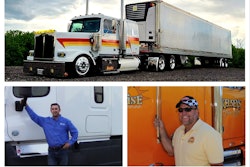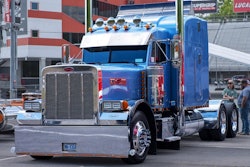Cross-country trucking contains its share of frustrations. Among the most common frustrations, according to our readers, are the varying laws and levels of enforcement they encounter as they move from state to state. Leading the list of frustrations, according to a recent Truckers News survey, are differing speed limits, lane restrictions, and size and weight rules off the national network. In fact, more than 57 percent of those responding to the survey said differing speed limits for cars and trucks and lack of uniformity among states were their greatest frustrations. Typical are comments like one from Shay Turner, an owner-operator from San Antonio, who notes that states such as California that post different speed limits for trucks and cars are a problem.
“California is a big pain because of the speed limits,” Turner says. “It makes it hard doing our jobs. Going from 75 miles per hour coming out of Arizona to going 55 miles per hour in California makes you really tired. It’s also dangerous when cars are doing 75 and you’re going 55. You get a lot of rear-end collisions from divided speeds.”
Robert Carr, a trucker from Lyles, Tenn., agrees. “Split speed limits are dangerous as cars are speeding and run up under trucks before they can get stopped or slowed down,” he says.

Since 1995, when Congress repealed the national speed limit for interstate and other federal highways, states are permitted to set any speed limit they choose. According to the Insurance Institute for Highway Safety, 44 states raised their speed limits after repeal of the national speed limit. The Insurance Institute says 10 states post lower maximum speed limits for trucks than for automobiles. Maximum truck speed limits range from 55 mph in states such as California, Illinois, Oregon and Michigan to as high as 75 mph in Utah, Wyoming, Arizona, New Mexico and Colorado. Maximum automobile speed limits also vary, from 65 mph to 75 mph.
The differential between maximum car and truck speeds also varies, from as great as 15 mph in California and Michigan (70 mph cars, 55 mph trucks) to as little as 5 mph in Indiana (65 mph cars, 60 mph trucks) and Arkansas (70 mph cars, 65 mph trucks).
“Split speed limits in California are about to be rethought,” says Joel Anderson, executive vice president of the California Trucking Association. According to Anderson, slower truck speeds and lane restrictions create a “wall of trucks” on some vital truck routes such as I-5, causing problems for motorists trying to enter the freeway.
“There may be too big a differential” in the speed limits, Anderson adds. “That can become a safety issue as there are more trucks on the road.”
Changing truck speed limits will not be easy, especially in California. Noting a rash of truck accidents in recent months, Stan Perez, chief of the California Highway Patrol’s Enforcement Services Division, says now “is not an appropriate time to consider raising truck speeds. When we have an increase in accidents, we’re looking at everything: speed, congestion and other factors.” Truck-involved and truck-at-fault collisions are up 4 percent in the state, according to the CHP.
Another key frustration with truckers is that some states enforce speed limits and other regulations with more zeal than other states. By an overwhelming margin, survey respondents listed California as the least trucker-friendly state in terms of regulations and enforcement.
California officials, on the other hand, don’t seem to be fazed by that distinction. “We’re enforcing the law,” says Anne DeVigo, from the CHP’s department of public affairs. “If it’s unfriendly to enforce the law, you can draw your own conclusions on that.
“Certainly you can say trucks in California are safer than anywhere else in the country,” DeVigo adds. “The trucks that cross the border from Mexico are as safe as other trucks on the road because we check those trucks at the border.”
From DeVigo’s perspective, vigorous enforcement means safer highways. “Truckers coming into California know they have to have their trucks in good shape, and that’s not a bad thing.”
According to U.S. DOT data, California’s large-truck fatal crash involvement rate per 1 million miles in 1999 was 10th lowest in the nation at 1.3 percent. States with higher fatal truck crash rates of 2 percent or more included Alabama, Florida and Kansas.
An earlier DOT inspector general’s report noted that FMCSA lacked sufficient data to draw a sharp relationship between enforcement and safety. As part of its 10-year plan to improve highway safety, the agency has begun collecting such data.
Size and weight issue
While speed limits, overly zealous enforcement officers and lane restrictions may rank as most bothersome to the truckers behind the wheel, perhaps the most contentious issues from a political standpoint are size and weight laws. According to a Transportation Research Board report published in 2000, “As presently conceived, U.S. truck size and weight limitations are a mishmash of federal, state and local requirements.”
Federal involvement in truck size and weight issues didn’t begin until 1956, with the Federal-Aid Highway Act. The act was part of the federal program for constructing the Interstate and Defense Highway System. Those rules set maximum truck width at 96 inches and limits including a single-axle weight of 18,000 pounds, tandem-axle weight of 32,000 pounds, and gross vehicle weight of 73,280 pounds. In 1974, Federal-Aid Highway Amendments were passed which increased weight limits on interstates to 20,000 pounds for single axles, 34,000 pounds for tandem axles and a maximum GVW of 80,000 pounds. But the act did not mandate that states adopt the increased weights. According to the Federal Highway Administration, when six Mississippi Valley states refused to increase their interstate GVWs to 80,000 pounds, they created a barrier to cross-country interstate commerce.
As a result, Congress passed the Surface Transportation Assistance Act of 1982 that expanded federal authority over truck size and weight on interstates, other federal-aid primary roads and other routes considered part of the national network. The STAA set the maximum width allowed to 102 inches and also prohibited states from limiting overall length of a tractor and 48-foot semi-trailer combination, or a tractor and two 28-foot semi-trailers. States were also prohibited from limiting trailer lengths to less than 48 feet on the national network.
Despite the action by federal regulators to set truck size and weight standards on the national network, off the network, states still have the authority to set size and weight limits. According to the FHWA’s “Comprehensive Truck Size and Weight Study” submitted to Congress last fall, when the four basic weight limits (single axle, tandem axle, bridge formula and gross vehicle) are applied both on and off the interstate system in the 50 states, the result is 40 different combinations. Only seven states apply federal limits statewide. The study concluded, “In a sense, each state has a different weight limit ‘package.'”
According to the size and weight study, 14 states have single-axle limits greater than the federal standard on the national network and 17 states have higher single-axle limits off the interstate. Three states set weight limits below the national standard.
Twenty-one states have tandem-axle limits higher than federal standards off the national network, 15 states allow a higher limit on the interstate and two states impose tandem limits below the federal limit off the network.
Four states have grandfathered rights to exceed 80,000 pounds GVW on the interstate, and 18 states allow more than 80,000 pounds off the national network. Five states imposed GVWs of less than 80,000 pounds on some of their non-interstate roadways.
The report says there are 28 different permitted GVW limits for a five-axle unit ranging from 80,000 pounds up to 155,000 pounds, depending on the state. There are 16 different single-axle limits and 17 different tandem-axle limits.
For trailer lengths, 10 states allow semi-trailers more than 53 feet in length, while only Alaska and Rhode Island restrict trailers to less than 53 feet.
The FHWA sees truck size and weight as both a safety and productivity issue. For shippers and carriers, longer trucks mean greater productivity. But many public agencies and interest groups are concerned about safety and preserving highway infrastructure, according to FHWA. These groups oppose longer trucks and were the force behind a freeze on the operation of longer combination vehicles included in the Intermodal Surface Transportation Efficiency Act of 1991. Under the act, states cannot expand LCV operations beyond routes in use in 1991. LCVs include triples, turnpike doubles and other longer combinations. According to the FHWA, LCVs are operated in 14 Western states and in six other states on certain turnpikes. For Western truckers, the LCV freeze has become a major issue.
Some states have asked Congress to lift the freeze, while others want to do away with LCV operation altogether.
“Congestion, hours-of-service and other issues play into the productivity solution” of longer trucks, says CTA’s Joel Anderson. But Anderson believes the industry must first convince the public on the safety issue before there’s a chance of “unfreezing the freeze.”
“I don’t think we can move on the freeze until the public is convinced by the industry that safety is our No. 1 priority,” Anderson says. “The economics, in terms of increased productivity, are in our favor, but you’ve got to work through the safety noise.”
The bottom line on truck size and weights according to the FHWA: The differences among states on size and weight issues are increasing over time because of “differences in local and/or regional political choices that have been made” regarding freight movement. Federal efforts at standardizing truck size and weight are limited to the national network, while states make their own choices for roads under their control.








